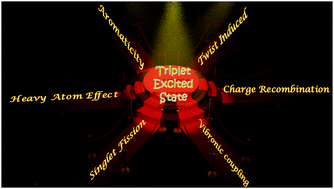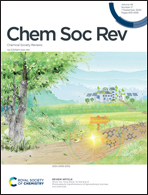Access to the triplet excited states of organic chromophores
Abstract
Over the last several decades, exploring the pathways to access the triplet excited states of organic chromophores has been a stimulating area of research. Among the numerous photoinduced processes in organic chromophores, analysis of intersystem crossing (ISC) dynamics has received immense attention. The ISC process involves a spin-forbidden horizontal transition from an excited singlet state to a higher vibrational level of the isoenergetic triplet state. Generally, ISC necessitates a strong driving force from efficient spin–orbit coupling (SOC) between the singlet and triplet wavefunctions. The magnitude of SOC can be tuned by the substituent groups (e.g. heavy atoms, carbonyl moieties) or by the out-of-plane vibrational modes in the chromophores. Besides the SOC induced ISC pathway, triplet excited states are also realised in organic chromophores through singlet fission or via charge recombination. Accessing the triplet manifold in π-conjugated systems would also include a possible evolution to more aromatically stable configurations in the excited states, an emerging area that needs attention. In the aforesaid mechanisms, the molecular architecture and/or packing arrangement of the chromophores are vital for the effective population of triplet states. We, herein, present a collection of synthetic, spectroscopic and theoretical investigations that provide insights into the diverse pathways to access triplet excited states in organic chromophores. We believe this tutorial review would prove beneficial for researchers to achieve triplet excited states of organic chromophores for numerous biochemical and optoelectronic applications.



 Please wait while we load your content...
Please wait while we load your content...